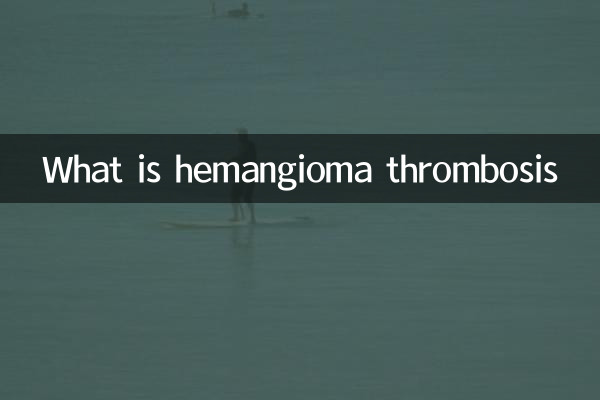What is hemangioma thrombosis
Hemangioma thrombus is a blood clot that forms in or around a hemangioma, a benign tumor formed by abnormal growth of blood vessels. This phenomenon may be triggered by a variety of factors, including hemodynamic changes, endothelial damage, or coagulation abnormalities. Although hemangioma thrombosis is common in infantile hemangiomas, it may also occur in other types of hemangiomas. This article will combine recent hot topics on the Internet to analyze in detail the causes, symptoms, diagnosis and treatment methods of hemangioma thrombosis, and provide structured data for reference.
1. Causes of hemangioma thrombosis

The formation of hemangioma thrombosis is usually related to the following factors:
| Cause | Description |
|---|---|
| Hemodynamic changes | The blood flow in the hemangioma is slow or turbulent, which can easily lead to platelet aggregation. |
| endothelial injury | Abnormal proliferation of endothelial cells in hemangiomas may trigger local coagulation reactions. |
| Abnormal coagulation function | Abnormalities in the patient's own coagulation mechanism (such as antiphospholipid antibody syndrome). |
| external stimulus | Trauma, infection, or medication may induce thrombosis. |
2. Symptoms of hemangioma thrombosis
Symptoms of thrombosis vary depending on the location and size of the hemangioma. Common manifestations include:
| Symptoms | Description |
|---|---|
| local pain | The blood clot causes the hemangioma to swell or compress the nerve. |
| skin color changes | The hemangioma area is purple-red or bluish-purple. |
| a hard knot or lump | The hemangioma may feel hardened on palpation. |
| Fever or signs of infection | Redness, swelling, heat and pain may occur when combined with infection. |
3. Diagnostic methods
The diagnosis of hemangioma thrombosis requires a combination of clinical examination and imaging techniques:
| Check method | function |
|---|---|
| Ultrasound examination | Assess blood flow status and location of thrombus. |
| MRI | The relationship between hemangioma and surrounding tissue is clearly shown. |
| D-dimer detection | To assist in judging thrombus activity. |
| Pathological biopsy | Rarely used to identify malignant lesions. |
4. Treatment and Prevention
Treatment options need to be developed based on the severity of the blood clot and the age of the patient:
| Treatment | Applicable situations |
|---|---|
| anticoagulant therapy | Low-dose aspirin or low-molecular-weight heparin is used to prevent expansion. |
| local injection | Glucocorticoids or sclerosing agents shrink hemangiomas. |
| surgical resection | For large or life-threatening thrombotic hemangiomas. |
| physical therapy | Compression therapy improves symptoms of superficial hemangiomas. |
5. Related topics of recent hot topics
In the past 10 days, hot topics in the medical and health field include"Spontaneous regression rate of infantile hemangioma"and"Clinical Application of New Anticoagulant Drugs". A study published in the Journal of Pediatrics pointed out that about 60% of infantile hemangiomas can resolve spontaneously before the age of 5, but cases with blood clots require active intervention. In addition, the latest oral anticoagulants approved by the US FDA provide a new option for complex hemangioma thrombosis.
Summary
Hemangioma thrombosis is a common complication of hemangioma, and timely diagnosis and individualized treatment are crucial. After the scope of the thrombus is clarified through ultrasound or MRI, anticoagulation, injection or surgery can be combined to improve the prognosis. If parents find that infantile hemangiomas suddenly enlarge or change color, they should seek medical attention immediately to check for possible blood clots.

check the details

check the details